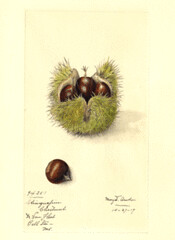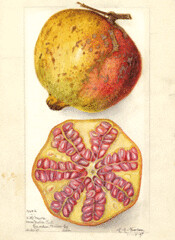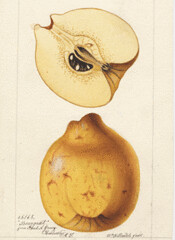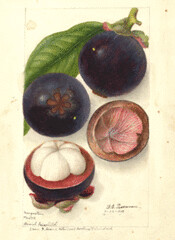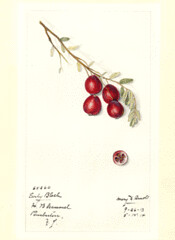When shopping for fruit and nut trees (or just flipping idly through nursery catalogs), one common issue is that many species require another of their species to provide pollen in order to set fruit. Most fruit crops produce flowers which are both male and female, and produce plenty of pollen. In some cases odd ploidy can result in plants incapable of producing viable pollen at all (or very small amounts, anyway), and a few species are dioecious (having male and female flowers on separate plants). But in many cases, the plants in question produce perfectly good pollen. Nursery catalogs are full of little pollination tables and warnings of "requires a pollinator" or, strangely enough, something along the lines of "[Cultivar X] will not pollinate [Cultivar Y]".
The reason for this is a phenomenon called self-incompatibility (SI). As inconvenient as it is for those of us who would like to just plant our favorite cultivar and nothing else, self-incompatibility serves a useful purpose evolutionarily. The whole point of sexual reproduction is to encourage assortment and exchange of genes, and yet by generally self-fertilizing (which they do by having male and female reproductive organs mature simultaneously and adjacent to each other), many species have sacrificed this evolutionary opportunity in exchange for a better chance of producing offspring, with the downside that those offspring will be merely reassortments of the parent's genes, not new mixtures of two individuals. Self-incompatibility evolved to prevent self-pollination in such cases, helping to avoid inbreeding depression.
There are two major SI systems in fruit crops, and both are really quite simple, though the implications are not necessarily so. Both involve interactions involve alleles of a single gene, called the "S" locus, which is why the basic genetics of it were worked out nearly a hundred years ago.
Gametophytic self-incompatibility, the most common form, is most commonly seen in sweet cherry (
Prunus avium, which, coincidentally, I'm eating a giant bag of right now), though it's also found in a number of other fruit and nut species including almond, Japanese apricot, roses, arctic bramble and assorted diploid blackberries and raspberries. Under this scheme, the haploid genotype of the pollen is the factor determining whether pollination can occur. Each pollen grain receives one of the two S-alleles of the parent, and that pollen is unable to germinate on flowers of individuals which possess the same S-allele. So, for example:
If you have a cherry tree with the S-genotype of S1S2, the pollen grains produced will be either S1 or S2. Neither can fertilize the tree's own flowers, since both S1 and S2 are present in the female. But say a neighoring tree is S1S3. It can produce S1 and S3 pollen. The S1 grains won't be able to germinate on either tree's flowers, but the S2 grains of the first tree can fertilize the second, and the second's S3 grains can fertilize the first. If we propose third tree, S4S8, appears on the scene, then both the other plants, having neither S4 or S8, will be able to fertilize it, as well as the reverse. There are quite a few different S-alleles in cherry, so the odds of getting two cultivars with the exact same complement is pretty small, but it can happen (for example, 'Bing' and 'Emperor Francis' are both S3S4). A nice diagram of gametophytic SI is available
here.
The other system is called sporophytic incompatibility. This one's a bit less common, particularly in fruit. The example that springs to mind is hazelnut (
Corylus species). The situation is similar to the gametophytic system, in that it depends on a pair of S-alleles. But there is one critical difference: in gametophytic SI, the compatibility phenotype of the pollen grain depends on the genotype of that grain, while under sporophytic it is the genotype of the parent that matters. So while a S1S2 GSI plant produces pollen grains with S1 or S2 genotypes, and corresponding S1 or S2 compatibility phenotypes. However, under SSI, while pollen grains are still genotypically S1 or S2, they all will share the dominant S-alleles phenotype (in this case S1). So a S1S2 SSI plant would produce pollen grains carrying the S2 allele, but effectively S1 for pollination purposes, so it could pollinate a S2S3 plant. An interesting twist is that while GSI plants are always heterozygous (with one minor exception which I will get to), SSI plants can carry two identical S-alleles, because it the actual genotype of the pollen is not related to the phenotype. It also adds the extra complication of the needing to know the dominance hierarchy of the S-alleles (which, inconveniently, is not simply numerical order. It's actually something like: (3, 8), (6), (1, 5, 7, 10, 12, 14, 15, 16, 17, 18, 20, 21, 24), (2, 25), (19), (9, 11, 22, 26), (23), (4), with dominance running from dominant on the left to recessive on the right (alleles in the same set of parentheses are roughly equivalent in dominance).
Researchers have, however, managed to come up with a convenient end-run around GSI in cherry. Scientists pollinated 'Emperor Francis' (S3S4) with irradiated pollen from 'Napoleon' (also S3S4). Normally, with both parents having the same S-alleles, no cross could occur. But a few seeds did set, because the radiation had damaged the chromosomes in some of the pollen grains, and, completely randomly, had damaged the S4 allele carried in one of them. The resulting seedling was JI 2420, which broke the rule I just mentioned above by being S4S4. However, one of those S4's was non-functional, and could pollinate any sweet cherry, including itself. The value of this was obvious, and JI 2420's amazing allele was immediately incorporated into a new cultivar, called 'Stella'. Nearly all self-compatible sweet cherries carry S4', the modified S4 from 'Stella'. While the trait is undeniably useful, the dependence on a single source is worrisome from a genetic diversity standpoint, and Amy Iezzoni, cherry breeder from Michigan State, has suggested that there may be some undesireable linkages associated with Stella's S4' gene. (Another self-compatible selection, JI 2434, came from the same experiment as JI 2420 and has been found to carry a second self-compatibility gene, this one a modification of the S3 allele (cleverly indicated S3'). So there's at least another option out there. Similar self-compatibility alleles exist in almond, Japanese apricot, and probably
Rubus, having occurred naturally and been selected.
So next time you see those compatibility tables in the nursery catalog, see if you can puzzle out the S-allele genotypes based on the information given. And don't forget to buy a pollenizer!
Labels: cherries, Corylus, Fruit Genetics Friday, genetics, hazelnut, Prunus



